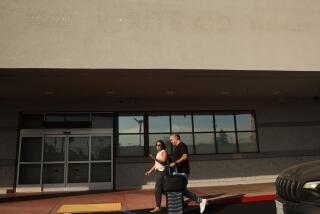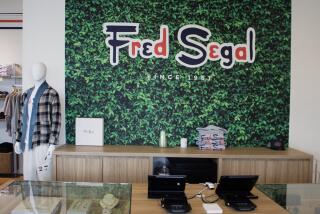Quick as a Wink : Southland Is Battleground for One-Hour Eye-Care Shops That Promise Convenience and Quality
Enraged by an umpireâs call at a recent San Diego Padres baseball game, a fan rose to his feet and questioned the eyesight of the official by making a strong and unconventional request.
âGo see Dr. Leventhal!â he yelled.
The comment was an off-beat testament to Alan Leventhal, head of a chain of Southern California stores that made its mark by being among the first in California to promise one-hour service. In the early 1980s, Leventhal gained celebrity status in San Diego--and an edge over competitors--by appearing in television commercials for his Vision Care Centers.
Now Leventhal and other local retailers of eye frames and contact lenses are being challenged as national chains move into the state with their own brand of 60-minute service.
Lured by a growing market and responding to the demand for convenience, some chains are building or renovating outlets with lens-grinding laboratories designed to fill prescriptions in an hour. Cincinnati-based Precision LensCrafters established its one-hour operations in California in 1986 and now has 41 stores in the state. Dallas-based Pearle Health Services took the one-hour plunge in August when it acquired Eye + Tech, formerly a Houston-based quick-service chain.
Pearle is converting 13 California Eye + Tech outlets into Pearle Vision Express stores that, unlike its 16 conventional stores in the state, are specially designed for 60-minute service. Eye Care Centers of America, with headquarters in San Antonio, has set up two so-called superstores in California.
Stiff Competition
In response, some local independent operators have been switching to one-hour service.
âItâs become very competitive,â said Leventhal, chairman of a 10-store San Diego-based chain. âItâs hard to predict what will happen within a six-month period. Thereâs enough (business) for everyone, but you have to fight for it.â
The one-hour phenomenon is an attempt to attract baby boomers, according to Marc Ferrara, editor of Optical Index, a trade publication in New York. Those in their 30s and 40s are an important segment of the market because as they grow older, their need for corrective lenses grows dramatically. Much of the new demand stems from a rise in presbyopia, a type of farsightedness that develops among many people in their 40s.
The impact of baby boomers on the industry is just beginning to register. The number of eyeglasses and contact lenses sold in the United States rose from about 52 million pairs in 1985 to 63 million in 1987, a rise of more than 20%. The trend is likely to continue. More than 90% of the U.S. population over age 45 wears some form of corrective lenses. That segment of the population totaled 76 million in 1985 and is projected to reach 124 million by 2010.
âEveryone is excited about the demographics,â Ferrara said. âThe baby boomers will create a boom in sales as they reach 40 and begin to buy more glasses. Retailers are looking; they see an immature business retail-wise and they see they can get more (sales) per store.â
The fight for sales in Southern California is an important part of a nationwide struggle for shares of a growing market. The $750 million that Californians spend annually for corrective lenses represents nearly 8% of the total spent on eyeglasses and contact lenses in the United States, according to industry analysts.
Nearly 10% of the $10 billion spent on corrective lenses in the past 12 months was at superstores, outlets with lens-grinding labs and quick service, according to a soon-to-be-released study by 20/20, a trade magazine based in New York.
Nationally, the number of superstore outlets has climbed from about 250 in 1986 to 725 this year, according to 20/20.
Traditional retailers of corrective lenses have responded to the superstoresâ one-hour challenge by shortening their delivery time, Ferrara said.
âSuperstores have come along and put pressure on traditional providers of eye wear,â Ferrara said. âTheyâve revolutionized the delivery of the product.â
Flint, Mich.-based Nu Vision, which has 50 California stores, entered the state in 1986 by acquiring another chain, Santa Barbara-based Rips Eyeglasses Unlimited. Nu Vision has a one-hour shop in San Bernardino and reduced delivery time at its other stores to three to seven days just this year, according to John MacDougald, vice president of Nu Visionâs Western region.
âIn general, consumers are expecting an enhanced level of service,â MacDougald said.
Nu Vision will compete by offering its customer high quality at competitive prices, said Jonathan Raven, executive vice president at Nu Vision. The quality of the product or the service is not always top-notch at one-hour operations, he said.
âConvenience is important, but the value of the product is equally important and some people donât need glasses in an hour,â Raven said. âSometimes they can get better service if theyâre willing to wait. . . . Service after the sale is important too.â
Independent optometrists are also trying to adjust to the new environment. Ed Elliot, a Modesto-based optometrist who serves on the national board of the American Optometric Assn., said private practitioners are pooling their money to buy materials in larger volumes to get lower prices.
Executives at some chains say the quality of care increases with more competition and that their growth and success is largely because of customer satisfaction. However, Elliot said some retailers are too interested in promotions that generate revenue. When one-hour chains proliferate in a relatively unregulated environment, quality suffers, he added.
âItâs a matter of hype, as opposed to spending that money on care,â he said.
Among those advertising is LensCrafters, which--with 262 outlets--is the largest chain of quick-service superstores. LensCrafters approaches the public on three fronts: television, newspapers and direct mail.
Convenience-Oriented Life Style
âCompanies are vying for peopleâs attention,â said Bruce Solomon, director of LensCraftersâ division for the California market. âThe convenience factor is very, very important. Considering the fact that there are more two-income homes--both the husband and wife working--people are more time conscious.â
Kathy Kirk, marketing director for the local Dr. Leventhalâs chain, said: âThe biggest push for quick service industrywide in California came when Lens-Crafters started here . . . two years ago.â
Pearle, which also uses the media and direct mail to promote its stores, is opening more one-hour outlets to keep pace with a life style trend, said Jeff Melyond, director of marketing for Pearleâs California operation.
âThe whole way we live now is convenience-oriented,â he said. âPeople want a quality product, and they want it in the least time possible.â
After recent acquisitions, Pearle has the second-largest number of superstores. EyeCare Centers of Americaâs EyeMasters chain ranks third, and Cole National, parent of Eyelab, follows closely in fourth.
Analysts say more competition can be expected as new and existing chains try to grab part of the 70% of the annual sales garnered by more traditional practitioners such as opthalmologists, optometrists and opticians, according to a report by Furman Selz Mager Dietz & Birney, a New York-based investment house.
Conglomerates and large retailers are among those struggling for a share. The U.S. subsidiary of the British conglomerate Grand Metropolitan bought Pearle, the national sales leader, in 1985. LensCrafters, second in sales, is owned by U.S. Shoe. Sears, Roebuck & Co., the nationâs largest retailer, last year acquired Eye Care Centers of America, a chain of superstores. Eye Care, which has about 60 outlets nationwide, has indicated that it plans to open about 450 additional stores in the United States by 1992.
The large parent companies also have a big financial stake in their chains. With the financial backing of their parent firms, the national chains are expanding rapidly and are consolidating the superstore market, according to Jody Stone, editorial director of 20/20 magazine. Stone said the chains typically spend $750,000 to $1 million to build one superstore--$500,000 of that for each lens-grinding lab.
âCalifornia is so attractive in terms of revenue that Pearle, LensCrafter and Eye Care of America will do all it can to crack the market,â Stone said. âAnd theyâll do it through superstore expansion.â
This expansion disturbs Leventhal, who has yet to venture beyond his base in San Diego and Los Angeles.
âThe national chains have the money to force their way into this market,â he said. âThey can afford to spend and spend to get business. I donât like competing with the large corporations. Their expansion . . . will definitely suppress my ability to be a solid regional entity.â
More to Read
Inside the business of entertainment
The Wide Shot brings you news, analysis and insights on everything from streaming wars to production â and what it all means for the future.
You may occasionally receive promotional content from the Los Angeles Times.










